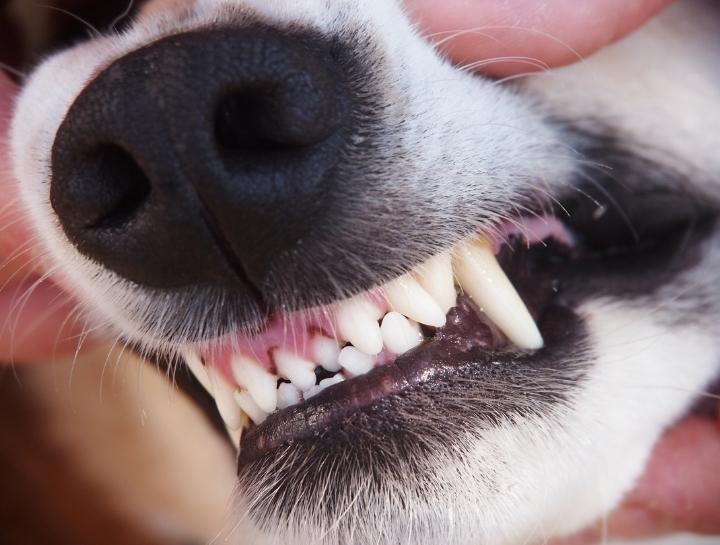Periodontal Disease—The Doggy Dentist (and Kitty Too!)

You’ve noticed for a while that your dog has bad breath; well, “bad” is putting it mildly. Maybe you flipped your pooches lip back and saw a row of brown teeth instead of pearly whites. Or maybe you just brought your pet in for a routine wellness exam and your veterinarian expressed concern about their dental health. Whatever the case may be, you’re faced with the prospect of your pet needing a dental cleaning. But just what are the exact reasons for needing a dental cleaning and what are your options?
Why do my pet’s teeth need to be cleaned?
Just as our teeth need daily maintenance to stay clean and healthy, a pet’s teeth do as well. While crunchy food, as well as specialty treats and toys, can help, daily brushing is ideal to remove plaque that naturally forms. When plaque is allowed to remain on the teeth, it hardens and forms tartar or calculus. Once this happens, calculus is too hard and firmly attached to the surface of the tooth to be removed with a toothbrush. This is one reason why professional dental cleaning is required. Long-term contact with plaque can also cause inflammation of the gums known as gingivitis. Pets as well as humans can suffer from gingivitis and the pain associated with it. Dental care at this stage of dental disease can prevent it from progressing and developing into periodontal disease.
What is periodontal disease?
Periodontal disease is inflammation of some or all of the tooth’s support. Periodontitis can cause bone loss, infection, and loose, painful teeth and may lead to internal disease. A primary sign of periodontal disease is bad breath or halitosis. “Dog breath” may immediately conjure up thoughts of a smell so bad it could make flowers wilt, but a healthy dog’s or cat’s breath should not have a disagreeable odor. When periodontal disease advances, your pet may lose the ability to chew hard food and may drool excessively—there could even be blood present. Some indicators of periodontal disease may be subtle though, and many pets show no obvious outward signs, although they may still be experiencing significant disease and discomfort.
How do we diagnose periodontal disease?
Since the tell-tale sign of bone loss from periodontal disease occurs below the gum line, we need to examine your pet under general anesthesia to evaluate how far the disease has progressed. This is also the best time to take x-rays and perform an unobstructed visual exam so that we can use specialized instruments to measure bone loss. Only then do we have a complete picture and are able to prescribe the best treatment.
What is involved in cleaning my pets’ teeth under anesthesia?
Proper and thorough cleaning of the teeth requires the complete cooperation of the patient so plaque and calculus can be removed. Since a pet can’t sit still and say, “Ah,” anesthesia is required to thoroughly clean the teeth. Although there is a degree of risk involved with general anesthesia, its use is extremely safe when properly administered by trained individuals. In the vast majority of cases, the risks associated with an untreated dental disease far outweigh any risk from anesthesia. Furthermore, a pre-anesthetic examination and blood test will help the doctor determine if your pet is healthy enough for general anesthesia and decide on the best anesthetic protocol for your pet.
After an overnight fast, your pet will be checked in by a veterinary nurse on the morning of the dental cleaning. After an exam is performed by the doctor to ensure your pet is healthy enough to proceed with the procedure, the patient is given an injection of a sedative and an IV catheter is placed. This is so that your pet can receive intravenous fluids to ensure hydration and normal blood pressure during the procedure. The patient is then intubated while under sedation and placed under general anesthesia.
Your pet will be connected to monitors that one of the veterinary technicians will constantly observe to record blood pressure, heart rate, respiration, oxygenation, and body temperature. The other vet tech will take the digital dental x-rays and perform the cleaning. Each tooth is individually probed and examined for pockets and disease. Full-mouth dental x-rays are required to assess the parts of the mouth we can’t see—the root and bone surrounding the teeth. This is the time when we may find problems that we could never have identified while performing an exam while your pet was awake. Your pet’s doctor will oversee the entire procedure, evaluating the x-rays, and performing any extractions and oral surgery needed.
After the dental cleaning is finished, one of the veterinary technicians will be by your pet’s side while coming out of general anesthesia. Once the patient is awake, they are then transferred to a recovery cage to complete their recovery. You will receive a phone call to let you know how the procedure went and be able to pick up your pet later in the afternoon after meeting with the doctor. Medications may be prescribed to use after the cleaning to treat and help prevent the progression of dental disease.
What is the prognosis for periodontal disease?
Mild cases of gingivitis are treatable and can be prevented with good daily tooth brushing. However, once it has progressed to periodontal disease it can be treated and controlled, but not cured; therefore strict home care is required.
Is dental disease preventable?
Daily tooth brushing is the key to helping prevent plaque buildup from turning into calculus. Special foods and treats are also available to help control calculus, but are not nearly as effective and should never be used as a substitute for tooth brushing.
You may have heard of anesthesia-free dental cleanings provided by groomers and other non-veterinarians. Are they a good alternative? What do they involve? Read our anesthesia dental article to learn more.
